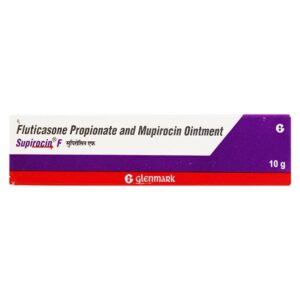BETAMETHASONE + MUPIROCIN
Betamethasone: Betamethasone is a corticosteroid drug that is used to treat various inflammatory conditions and diseases. It is available in different formulations, including pills, creams, ointments, lotions, and injections.
Betamethasone works by reducing inflammation and suppressing the immune response in the body. It binds to specific receptors in target cells, leading to the regulation of the genes responsible for inflammation and immune response. This helps in reducing swelling, redness, itching, and other symptoms associated with inflammatory conditions.
The dose of betamethasone varies depending on the formulation and the condition being treated. For example, topical creams and ointments are usually applied to the affected area 1-4 times a day. The dose for oral tablets ranges from 0.6 mg to 6 mg per day, depending on the condition. Injections are typically given by a healthcare professional.
While betamethasone is effective in treating various conditions, it may also cause some side effects. Common side effects include skin irritation, burning or stinging sensation at the application site, dry skin, acne, and changes in skin color. Prolonged use or high doses of betamethasone may increase the risk of systemic side effects such as adrenal suppression, Cushing’s syndrome, weight gain, fluid retention, increased blood pressure, high blood sugar, and osteoporosis. It is important to follow the prescribed dose and duration of treatment to minimize these risks.
Betamethasone should not be used on open wounds, infected areas, or near the eyes. It may interact with other medications, so it is important to inform your healthcare provider about all the drugs you are taking. Pregnant women or those who are breastfeeding should consult with their doctor before using betamethasone.
Overall, betamethasone is an effective corticosteroid drug used to treat various inflammatory conditions. However, it should be used under the supervision of a healthcare professional to minimize side effects and ensure the appropriate use and dosage.
Mupirocin: Mupirocin is an antibiotic medication that is commonly used to treat skin infections caused by bacteria. It is available in various forms such as ointment, cream, and nasal ointment.
The primary use of Mupirocin is to treat skin infections like impetigo, infected wounds, folliculitis, and secondary infections in eczema. It is also effective in preventing the spread of bacteria in the nasal passages, particularly methicillin-resistant Staphylococcus aureus (MRSA).
Mupirocin works by inhibiting bacterial protein synthesis. It specifically targets and binds to bacterial isoleucyl transfer-RNA synthetase, which is essential for protein synthesis in bacteria. This prevents the bacteria from producing vital proteins needed for their growth and replication, ultimately killing them or inhibiting their growth.
The dosage and duration of Mupirocin treatment depend on the severity and type of infection. Typically, for skin infections, a thin layer of the ointment or cream is applied to the affected area three times a day for up to 10 days. For nasal infections, a small amount of nasal ointment is applied into each nostril twice a day for up to 5 days.
Common side effects of Mupirocin include mild burning, stinging, or itching at the application site. These side effects are usually temporary and resolve on their own. Rarely, allergic reactions may occur, characterized by rash, hives, itching, swelling, or difficulty breathing. If any severe or persistent side effects occur, medical attention should be sought immediately.
It is important to note that this is a general overview of Mupirocin, and the specific instructions and precautions provided by a healthcare professional should always be followed when using this medication.

